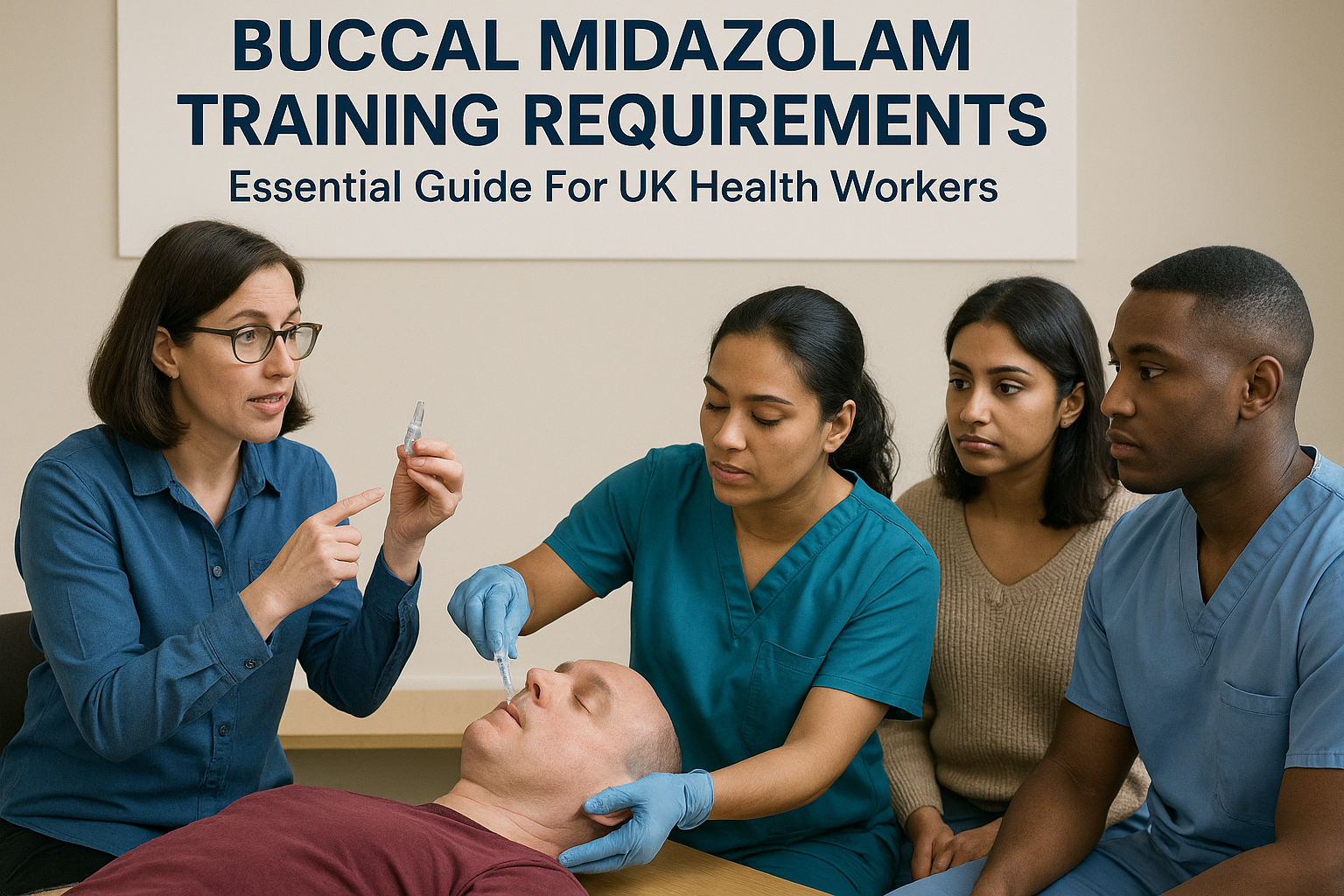UK Mandatory Staff Training: Legal Requirements & Key Courses


Mandatory Employee Training Requirements: Complete UK Guide 2025
Getting mandatory staff training wrong doesn't just create compliance headaches—it exposes your organisation to unlimited fines, voided insurance, and civil liability if someone gets hurt. UK employers face a complex web of statutory training requirements from multiple pieces of legislation, plus sector-specific courses that vary wildly depending on your industry.
This guide breaks down exactly which training UK law requires, which courses apply universally versus by sector, how often you refresh each qualification, and how to build a compliant training matrix that covers every role in your organisation.
Statutory vs Mandatory Training in the UK
UK employers face legal obligations to provide health and safety training under laws like the Health and Safety at Work Act 1974, which requires organisations to protect employee safety through adequate training, information, and equipment. The terms "statutory" and "mandatory" training get used interchangeably in most workplaces, but they actually mean different things—and the distinction matters when you're trying to figure out what your organisation legally owes its staff.
Statutory training refers to courses explicitly required by UK legislation. These are non-negotiable legal requirements backed by specific acts and regulations, like fire safety training under the Regulatory Reform (Fire Safety) Order 2005 or manual handling instruction required by the Manual Handling Operations Regulations 1992. If you skip statutory training, regulators can take enforcement action, prosecute your organisation, and impose unlimited fines.
Mandatory training describes courses that an employer or industry body determines are essential for safe service delivery and risk management, even when no single law explicitly names them. A care home might make conflict resolution training mandatory to comply with their broader legal duty to protect staff and residents from harm, even though no specific regulation requires "conflict resolution training" by name. Both types create binding compliance obligations—the difference lies in where the requirement originates and how it gets enforced.
Here's how they differ in practice:
- Source of requirement: Statutory training comes directly from legislation; mandatory training stems from employer risk assessments and sector guidance
- Enforcement mechanism: Statutory gaps trigger regulatory penalties; mandatory gaps create civil liability and insurance issues
- Applicability: Statutory training applies universally when specified conditions exist; mandatory training varies by organisation and role
- Penalties: Statutory breaches can lead to prosecution; mandatory training failures typically result in civil claims or failed audits
Current UK Laws That Drive Employee Training Duties
Several pieces of UK legislation create explicit or implicit training obligations for employers. The laws don't always prescribe specific courses, but they establish duties that can only be fulfilled through proper instruction and competence development.
Health and Safety at Work Act 1974
This foundational legislation places a general duty on employers to ensure, so far as reasonably practicable, the health, safety, and welfare of all employees at work. Section 2 specifically requires employers to provide "such information, instruction, training and supervision as is necessary" to ensure health and safety. This broad duty underpins most workplace training requirements—if a risk exists, the Act typically requires training to control it.
Management of Health and Safety at Work Regulations 1999
The regulations make risk assessment a legal requirement and explicitly state that employers have to provide adequate health and safety training when people are recruited, exposed to new or increased risks, or when working methods change. The training has to be repeated periodically where appropriate and adapted to account for new or changed risks. This creates an ongoing obligation, not just a one-time induction requirement.
Regulatory Reform (Fire Safety) Order 2005
The Fire Safety Order requires the "responsible person" (usually the employer) to provide all employees with adequate safety training on the action to take in case of fire. The training happens during working hours and gets repeated regularly to remain effective. Organisations also designate sufficient fire wardens or marshals and provide them with additional role-specific instruction on evacuation procedures, equipment use, and emergency protocols.
Equality Act 2010 and Related Regulations
The Equality Act creates duties that often require training to fulfil, even though people don't traditionally think of it as "health and safety" legislation. Employers have to take reasonable steps to prevent harassment and discrimination in the workplace. Providing staff with awareness training on protected characteristics, unconscious bias, and inclusive behaviour helps organisations demonstrate they've taken reasonable steps—a potential defence in tribunal claims.
Universal Courses Every Employer Provides
Certain training courses apply across virtually all UK workplaces, regardless of sector or size. These stem from common workplace hazards and universal legal duties that affect most organisations.
Fire Safety Awareness and Warden Training
Every employer provides fire safety awareness training to all staff, covering evacuation routes, alarm points, assembly areas, and the action to take on discovering a fire. The training typically occurs during induction and gets refreshed annually or whenever premises layouts change significantly.
Organisations also appoint competent persons to assist with fire safety measures—commonly called fire wardens or fire marshals. These designated individuals receive enhanced training covering sweep procedures, roll call responsibilities, basic fire extinguisher use, and how to assist vulnerable persons during evacuation. The number of trained wardens depends on building size, occupancy, and shift patterns.
Emergency First Aid at Work
The Health and Safety (First-Aid) Regulations 1981 require employers to provide adequate and appropriate equipment, facilities, and personnel to enable first aid to be given to employees if they're injured or become ill at work. "Adequate and appropriate" depends on your risk assessment, but most workplaces have at least one trained first aider per shift.
The HSE-approved Emergency First Aid at Work (EFAW) course provides a minimum level of competence for lower-risk environments, while the full First Aid at Work (FAW) qualification suits higher-risk settings. Both require practical assessment with a qualified instructor—online-only courses don't meet legal standards. Certificates remain valid for three years, though annual refresher skills sessions help maintain competence.
Manual Handling Training
If your employees lift, lower, push, pull, carry, or move loads as part of their work, the Manual Handling Operations Regulations 1992 apply. The regulations create a hierarchy of controls: avoid manual handling where possible, assess risks that can't be avoided, and reduce risks through training and equipment.
Manual handling training teaches safe lifting techniques, how to assess load characteristics, when to use mechanical aids, and how to plan tasks to minimise injury risk. The training gets tailored to the types of loads and movements your staff actually perform—generic courses often miss workplace-specific risks. Refresher training typically happens every one to three years depending on task complexity and injury history.
Display Screen Equipment Assessment and Training
The Health and Safety (Display Screen Equipment) Regulations 1992 protect employees who habitually use computers or similar display screens for significant portions of their working day. Employers analyse workstations to assess and reduce risks, provide adjustable furniture and equipment, and offer training on correct setup and posture.
DSE training helps prevent musculoskeletal disorders, eye strain, and fatigue. It covers chair adjustment, screen positioning, keyboard and mouse placement, lighting considerations, and the importance of regular breaks. The training happens when someone becomes a DSE user, when workstations change significantly, or when users report discomfort.
Basic Health and Safety Induction
Every new employee, temporary worker, and contractor working on your premises receives a site-specific health and safety induction before starting work. The induction covers the hazards present in your workplace, the control measures in place, emergency procedures, incident reporting processes, PPE requirements, and who to contact with concerns.
The induction gets tailored to the individual's role and the specific risks they'll encounter. A warehouse operative receives different information than an office administrator. While some elements can be delivered online, face-to-face discussion allows new starters to ask questions and demonstrates your commitment to their safety from day one.
Sector-Specific Mandatory Training Lists
Beyond universal requirements, different industries face additional training obligations based on their unique hazards and regulatory frameworks.
Healthcare and Social Care
Healthcare and social care settings face extensive training requirements driven by CQC registration conditions and professional standards. Infection prevention and control training—covering hand hygiene, PPE use, waste disposal, and outbreak management—is essential for all clinical and care staff.
Moving and handling training in healthcare contexts goes beyond basic manual handling to cover patient-specific techniques, equipment like hoists and slide sheets, and dignity considerations. Safeguarding training (both adults and children) is legally required for anyone working with vulnerable populations, covering how to recognise and respond to abuse, neglect, and exploitation. The Care Certificate provides a standardised induction framework for new healthcare support workers and adult social care workers in England, covering 15 standards including duty of care, communication, privacy, fluids and nutrition, and basic life support.
Construction and Trades
Construction sites present high-risk environments with specific training requirements. Most sites require workers to hold a CSCS card (Construction Skills Certification Scheme), which demonstrates they've passed a health, safety, and environment test appropriate to their occupation.
Role-specific training covers working at height (scaffolding, ladders, mobile elevated work platforms), confined space entry, hot works permits, and asbestos awareness. Site safety inductions familiarise workers with site-specific hazards, welfare facilities, emergency procedures, and reporting lines.
Hospitality and Catering
Food businesses have to ensure that food handlers receive appropriate supervision, instruction, and training in food hygiene matters commensurate with their work activities. In practice, most food handlers hold at least a Level 2 Food Safety and Hygiene qualification.
Allergen awareness training became even more critical following the introduction of "Natasha's Law" in 2021, which requires full ingredient labelling on prepacked for direct sale foods. Staff learn the 14 major allergens, cross-contamination risks, and how to respond to customer allergen enquiries accurately. Premises selling alcohol ensure staff understand their responsibilities under licensing laws, though individual personal licences are only required for designated premises supervisors.
Logistics and Warehousing
Forklift and other industrial truck operations require accredited training and assessment under the Provision and Use of Work Equipment Regulations 1998. Operators receive both basic training (leading to a certificate of basic training) and site-specific familiarisation before working unsupervised.
Drivers of goods vehicles over 3.5 tonnes complete Driver Certificate of Professional Competence (CPC) periodic training—35 hours every five years—to maintain their vocational driving entitlement. Warehouse staff handling hazardous goods may require ADR (dangerous goods) awareness, while those involved in loading receive training on load security, weight distribution, and vehicle/pedestrian segregation.
Office-Based Businesses
Office environments aren't risk-free, though hazards differ from industrial settings. Data protection training is essential for any staff handling personal information, covering UK GDPR principles, lawful processing bases, individual rights, breach reporting, and records retention.
Cyber security awareness training helps prevent data breaches, phishing attacks, and ransomware incidents—increasingly important as remote working expands. Topics include password hygiene, recognising suspicious emails, secure file sharing, and device security.
Refresher Cycles and Record-Keeping Standards
Training isn't a one-time event. Competence degrades over time, regulations change, and new risks emerge. Most training requires periodic renewal to remain valid and effective.
Common refresher intervals include:
- Emergency First Aid at Work: Certificates last three years; annual skills refreshers help maintain practical competence between formal recertifications
- Fire warden training: Typically renewed every one to three years depending on premises complexity and staff turnover
- Fire safety awareness: Annual refreshers or following significant premises changes
- Manual handling: Refreshers every one to three years based on task risk and incident history
- DSE training: Required on starting, when workstations change substantially, or if users report problems
- Safeguarding (care settings): Refreshed every one to three years aligned to local safeguarding board guidance
- Food hygiene: Typically renewed every three years, though earlier refreshers may be needed if procedures change
Maintaining accurate training records is a legal requirement under the Management of Health and Safety at Work Regulations. Your records include a training matrix showing who requires what training and when, attendance registers, certificates, competence assessments, and version-controlled training materials. Records demonstrate compliance during inspections, identify gaps before they become critical, support insurance claims, and provide evidence in legal proceedings.
How to Build a Compliant Training Matrix in Five Steps
Creating a comprehensive training programme prevents gaps and ensures every role receives appropriate instruction.
1. Map roles and hazards
Start by cataloguing every role in your organisation, including part-time positions, night shifts, contractors, and temporary workers. For each role, list the tasks performed, locations worked, equipment used, and substances handled. Conduct or review risk assessments for activities to identify specific hazards each role encounters—this forms the foundation of your training programme.
2. Match legal courses to identified risks
Link each identified hazard to the training required by law or industry standards. If a role involves lifting patients, staff receive healthcare-specific moving and handling training. If they work alone in community settings, they might receive lone worker safety training. Note any prerequisites—for example, forklift training requires candidates to be at least 16 and medically fit to operate machinery.
3. Schedule initial and refresh dates
Determine when training gets completed for new starters (some courses are needed before work begins, others within the first month) and set renewal cycles based on regulatory requirements and your risk assessment. Align training schedules with probation periods so competence can be verified before confirmation.
4. Select accredited providers
Choose training providers recognised by relevant awarding bodies—HSE, Ofqual, or sector-specific regulators. Verify instructor credentials (many first aid and manual handling instructors hold teaching qualifications themselves), review course syllabi to ensure they cover your specific risks, and check assessment methods include practical demonstration where appropriate.
Ready to book practical, engaging training for your team? Kasorb's experienced instructors—including paramedics, ER nurses, and NHS professionals—deliver hands-on courses at your workplace with flat group rates for up to 12 people. Book your session now and ensure full compliance with confidence.
5. Monitor completion and update records
Use a central training matrix, learning management system, or spreadsheet to track each employee's training status, certificate expiry dates, and upcoming renewals. Set up automated reminders for refreshers due within 30 to 60 days. When training is missed, escalate through line management and document follow-up actions.
Frequently Asked Questions About UK Mandatory Staff Training
Is online first aid certification accepted by the HSE?
No—purely online first aid courses don't meet HSE requirements for workplace first aid provision. Emergency First Aid at Work and First Aid at Work qualifications require practical assessment by a qualified instructor to demonstrate competence in techniques like CPR, wound management, and using an AED. While some blended courses include online theory components, the practical element and final assessment happen face-to-face.
Do volunteers require the same mandatory training as paid employees?
Yes, in most cases. The Health and Safety at Work Act and associated regulations protect volunteers performing work activities, not just paid staff. If volunteers face the same risks as employees—handling equipment, working with vulnerable people, or performing manual tasks—they receive equivalent training.
How quickly do new starters complete statutory courses?
Essential safety training gets completed before work starts or on the first day, particularly training related to immediate hazards like emergency procedures, PPE use, and equipment operation. Induction covering site-specific risks and controls typically occurs on day one. More comprehensive courses like full manual handling or first aid certification can be scheduled within the first month, provided adequate supervision and interim controls are in place until training is completed.


Book a free 15-min consult call with us. We’ll help you get your mandatory training done right.





